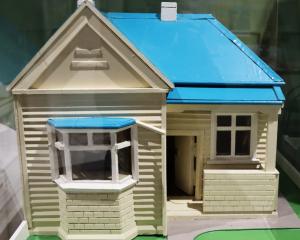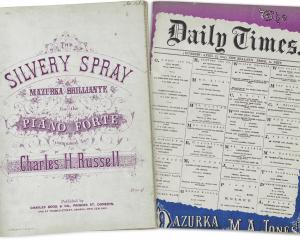
In a corner of Toitū’s A New Edinburgh Gallery a collection of stone shards provides a lament for a bygone era from a faraway country — with an Otago twist.

Alexander (also known as Alastair) inherited the title of clan chieftain upon the death of his father in 1851, but he also inherited a huge debt, forcing him to sell the last of the clan lands in Scotland — the Knoydart Estate — in 1857. Five years later, at the height of gold-rush Dunedin in June 1862, he died alone from rheumatic fever, probably at the Provincial Hotel on the corner of Manse and Stafford Sts.
Much of his life remains a mystery, including why he was in Dunedin at the time of his death. A death notice in the Otago Daily Times described him as "on his way to Canterbury". His brother, Charles, who would inherit Alexander’s title as chieftain, was farming in Canterbury at the time and probably paid for the small cross that marked Alexander’s grave.

In the mid-1890s, 30 years after the chieftain’s death, a movement was launched by sympathetic Scots from around Otago and Southland to mark the Glengarry grave with a monument befitting a Highland chief. This highlights the complex relationship Highlanders had with their clan leaders.
Despite Alexander’s family being responsible for the "clearing" and selling of their ancestral clan lands back in Scotland, many Highlanders still felt compelled to suitably honour their dead chieftain.
Loyalty to their Scottish origins remained strong and authentic. Subscriptions were raised from compassionate Scots around Otago and Southland, but the project was driven mainly by members of Clan Donald.
The funds were put towards an impressive Celtic cross with the clan crest and motto carved in stone, as well as memorial inscriptions for the dead chief. It was dedicated in 1897 at the Southern Cemetery. Unfortunately, little provision was made for the maintenance of such an impressive monument and the cross eventually fell into disrepair.

Led by Clan Donald, Dunedin-based and international Scottish organisations again launched a successful campaign to replace the cross with a new memorial.
A new solid-granite memorial stone was unveiled at the site of Alexander Ranaldson MacDonell’s grave and in 2006 the remains of the original cross were donated to Toitū Otago Settlers Museum.
As with the 1897 original monument, the new memorial included a Gaelic inscription that Toitū’s curator Sean Brosnahan has described as: "... being as much a lament for a lost Highland culture as for MacDonell himself".
Its English translation reads: "Erected by the Scottish Gaels of Dunedin and their families and their friends throughout Otago as a National Memorial of a great Chief who has departed, and for the days that are gone. 1897, Shoulder to Shoulder."
The original pieces of the 1897 Celtic cross displayed at Toitū today remain a curious connection between Otago, the Highland clearances and the clan chieftain whose death and burial links the two.
Will McKee is the exhibition developer at Toitū Otago Settlers Museum and producer of the Journey to New Edinburgh docu-series.








![‘‘Neil’s Dandelion Coffee’’. [1910s-1930s?]. EPH-0179-HD-A/167, EPHEMERA COLLECTION, HOCKEN...](https://www.odt.co.nz/sites/default/files/styles/odt_landscape_small_related_stories/public/slideshow/node-3436487/2025/09/neils_dandelion_coffee.jpg?itok=fL42xLQ3)



